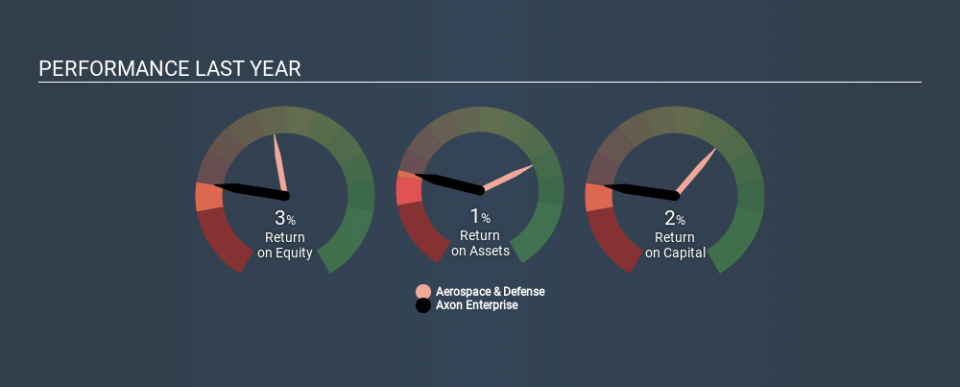Should Axon Enterprise, Inc.’s (NASDAQ:AAXN) Weak Investment Returns Worry You?

Today we'll look at Axon Enterprise, Inc. (NASDAQ:AAXN) and reflect on its potential as an investment. Specifically, we'll consider its Return On Capital Employed (ROCE), since that will give us an insight into how efficiently the business can generate profits from the capital it requires.
First of all, we'll work out how to calculate ROCE. Second, we'll look at its ROCE compared to similar companies. And finally, we'll look at how its current liabilities are impacting its ROCE.
Return On Capital Employed (ROCE): What is it?
ROCE measures the amount of pre-tax profits a company can generate from the capital employed in its business. In general, businesses with a higher ROCE are usually better quality. Overall, it is a valuable metric that has its flaws. Renowned investment researcher Michael Mauboussin has suggested that a high ROCE can indicate that 'one dollar invested in the company generates value of more than one dollar'.
So, How Do We Calculate ROCE?
Analysts use this formula to calculate return on capital employed:
Return on Capital Employed = Earnings Before Interest and Tax (EBIT) ÷ (Total Assets - Current Liabilities)
Or for Axon Enterprise:
0.022 = US$13m ÷ (US$792m - US$184m) (Based on the trailing twelve months to September 2019.)
So, Axon Enterprise has an ROCE of 2.2%.
View our latest analysis for Axon Enterprise
Does Axon Enterprise Have A Good ROCE?
One way to assess ROCE is to compare similar companies. Using our data, Axon Enterprise's ROCE appears to be significantly below the 11% average in the Aerospace & Defense industry. This performance could be negative if sustained, as it suggests the business may underperform its industry. Putting aside Axon Enterprise's performance relative to its industry, its ROCE in absolute terms is poor - considering the risk of owning stocks compared to government bonds. It is likely that there are more attractive prospects out there.
Axon Enterprise's current ROCE of 2.2% is lower than 3 years ago, when the company reported a 17% ROCE. So investors might consider if it has had issues recently. You can click on the image below to see (in greater detail) how Axon Enterprise's past growth compares to other companies.
When considering this metric, keep in mind that it is backwards looking, and not necessarily predictive. Companies in cyclical industries can be difficult to understand using ROCE, as returns typically look high during boom times, and low during busts. This is because ROCE only looks at one year, instead of considering returns across a whole cycle. Since the future is so important for investors, you should check out our free report on analyst forecasts for Axon Enterprise.
What Are Current Liabilities, And How Do They Affect Axon Enterprise's ROCE?
Liabilities, such as supplier bills and bank overdrafts, are referred to as current liabilities if they need to be paid within 12 months. Due to the way ROCE is calculated, a high level of current liabilities makes a company look as though it has less capital employed, and thus can (sometimes unfairly) boost the ROCE. To counter this, investors can check if a company has high current liabilities relative to total assets.
Axon Enterprise has total assets of US$792m and current liabilities of US$184m. As a result, its current liabilities are equal to approximately 23% of its total assets. This is not a high level of current liabilities, which would not boost the ROCE by much.
Our Take On Axon Enterprise's ROCE
That's not a bad thing, however Axon Enterprise has a weak ROCE and may not be an attractive investment. Of course, you might also be able to find a better stock than Axon Enterprise. So you may wish to see this free collection of other companies that have grown earnings strongly.
If you like to buy stocks alongside management, then you might just love this free list of companies. (Hint: insiders have been buying them).
If you spot an error that warrants correction, please contact the editor at editorial-team@simplywallst.com. This article by Simply Wall St is general in nature. It does not constitute a recommendation to buy or sell any stock, and does not take account of your objectives, or your financial situation. Simply Wall St has no position in the stocks mentioned.
We aim to bring you long-term focused research analysis driven by fundamental data. Note that our analysis may not factor in the latest price-sensitive company announcements or qualitative material. Thank you for reading.

 Yahoo Finance
Yahoo Finance 
